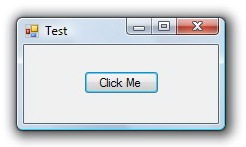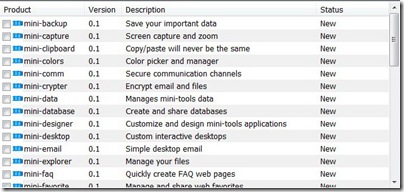Mar 04
There is No PaddingF
There is Point and PointF, Size and SizeF, Rectangle and RectangleF, Padding and… wait, there is no PaddingF!
System.Drawing vs. System.Windows.Forms
The 2-D drawing functions in the System.Drawing namespace accept both integer and floating point measurements. That’s why the main 2-D drawing structures have both int and float versions such as Point and PointF, respectively.
However, the Padding structure is defined separately in the System.Windows.Forms namespace where most 2-D measurements are in integers. Hence, there is an integer Padding structure but no floating point PaddingF.
Read the rest of this entry »
Oct 09
The standard Windows Forms ListBox control is not designed to display an icon with each item. You can modify the ListBox to handle the DrawItem event and manually draw the items and their associated icons, as shown here and here.
However, if you were hoping to use a standard off-the-shelf control with full icon support, your best bet is to use the ListView control.
Oct 09
To scroll a C# TextBox to the cursor/caret, it’s important that the TextBox is both visible and focused, then call the ScrollToCaret method:
textBox.Focus();
textBox.ScrollToCaret();
To scroll to the bottom/end of a TextBox, set the SelectionLength to 0 to remove any selection, then set SelectionStart to the end of the text in the TextBox:
textBox.SelectionLength = 0;
textBox.SelectionStart = textBox.Text.Length;
textBox.Focus();
textBox.ScrollToCaret();
Jun 10
This is one of those “D’oh!” moments. You’re creating your own UITypeEditor. You know the UITypeEditor class is located in the System.Drawing.Design namespace. So naturally you want to add to your Visual Studio project a reference to the System.Drawing.Design.dll, right? Wrong! When you compile your project, the following error may appear:
The type or namespace name ‘UITypeEditor’ could not be found (are you missing a using directive or an assembly reference?)
It turns out that UITypeEditor is actually defined in System.Drawing.dll, even though it’s located in the System.Drawing.Design namespace. See the disconnect? But you can easily solve this problem by adding to your Visual Studio project a reference to System.Drawing.dll.
Jun 08
When you create a Form with a border, Windows automatically draws a drop shadow around the form, as shown here:

However, if you set the form’s FormBorderStyle property to None, Windows draws neither the form border nor the drop shadow, as shown here:

Read the rest of this entry »
Feb 06
So you’ve set the ToolTipText property of a TabPage in a TabControl. When the user moves the mouse pointer over the tab, the text you specified is supposed to show in a tooltip.

But what if the tooltip is not showing? Fortunately, this problem has an easy solution:
Set the ShowToolTips property in the TabControl to true.
Jan 29
When showing a form that contains a TextBox, it’s common courtesy to focus the TextBox so that the user can begin typing immediately.
To focus a TextBox when a Windows Form first loads, simply set the TabIndex for the TextBox to zero (or the lowest TabIndex for any Control on the Form).
When a Form is displayed, it automatically focuses the Control with the lowest TabIndex. Note that if your TextBox is pre-initialized with some text, then the entire Text will be selected, as shown below:

Read the rest of this entry »
Jul 15
Sometimes it can be challenging to read the Details view in a ListView, especially if the rows are long. This article shows how to add shading to every second row to make a ListView easier to read.

Read the rest of this entry »
May 07
This is one of those things that’s obvious once you know it. When dealing with COM, there is often a need to convert a WinForms Form object to an IntPtr handle, and vice versa.
Read the rest of this entry »




